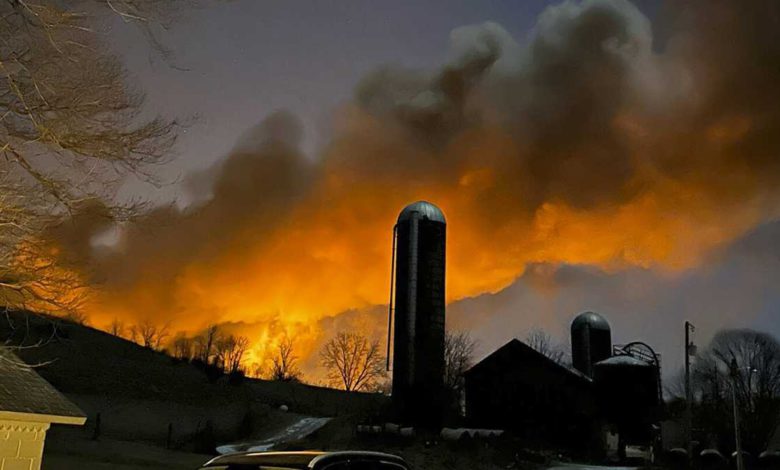

Greater Cincinnati Water Works officials said they're continuing to monitor the water quality of the Ohio River after trace amounts of two industrial chemicals leaked into the river due to a train derailment in East Palestine.Crews released toxic chemicals into the air last week from five derailed tanker cars that were in danger of exploding and began burning them after warning residents near the Ohio-Pennsylvania state line to leave immediately or face the possibility of death.Authorities in East Palestine had warned that burning vinyl chloride that was in five of the derailed tanker cars would send hydrogen chloride and the toxic gas phosgene into the air. They said subsequent air monitoring hasn’t detected dangerous levels inside or outside the mile-radius evacuation zone.Though the spill happened nearly 300 miles from Cincinnati, GCWW says it is part of a network of water utilities that constantly monitor the Ohio River and its tributaries. Officials said GCWW officials have been working, looking at how they would detect the chemical and how they'd handle the treatment process in Cincinnati. "During the past few days, GCWW scientists have looked at the size and location of the spill and calculated the travel time of the spill’s plume to reach Cincinnati. This is an advantage of the Ohio River, as its large size helps with diluting a spill, making it easier to treat," GCWW officials said.GCWW is also looking at how to treat the spill if the plume reaches Cincinnati."We know that trace amounts of this chemical can cause minor odors to the water, but through conventional treatment and the use of powdered activated carbon, we can ensure a supply of safe and healthy water remains available to our customers," GCWW said in a statement. Clermont County Water Resources Department also issued a statement saying they are aware of the train derailment and are monitoring the situation."Clermont County has three treatment plants, one of which is located in the southwestern portion of the County where it draws water from the Ohio River Valley Aquifer. This is a groundwater plant and does not draw water from the Ohio River. In an abundance of caution, if the contaminate plume still has concentrations at dangerous levels when it is passing by the area where our wellfield is located, Clermont County Water Resources may temporarily cease the operation of wells nearest the Ohio River bank until it is determined that the contaminate plume has passed," officials said in a statement.
Greater Cincinnati Water Works officials said they're continuing to monitor the water quality of the Ohio River after trace amounts of two industrial chemicals leaked into the river due to a train derailment in East Palestine.
Crews released toxic chemicals into the air last week from five derailed tanker cars that were in danger of exploding and began burning them after warning residents near the Ohio-Pennsylvania state line to leave immediately or face the possibility of death.
Authorities in East Palestine had warned that burning vinyl chloride that was in five of the derailed tanker cars would send hydrogen chloride and the toxic gas phosgene into the air. They said subsequent air monitoring hasn’t detected dangerous levels inside or outside the mile-radius evacuation zone.
Though the spill happened nearly 300 miles from Cincinnati, GCWW says it is part of a network of water utilities that constantly monitor the Ohio River and its tributaries.
Officials said GCWW officials have been working, looking at how they would detect the chemical and how they'd handle the treatment process in Cincinnati.
"During the past few days, GCWW scientists have looked at the size and location of the spill and calculated the travel time of the spill’s plume to reach Cincinnati. This is an advantage of the Ohio River, as its large size helps with diluting a spill, making it easier to treat," GCWW officials said.
GCWW is also looking at how to treat the spill if the plume reaches Cincinnati.
"We know that trace amounts of this chemical can cause minor odors to the water, but through conventional treatment and the use of powdered activated carbon, we can ensure a supply of safe and healthy water remains available to our customers," GCWW said in a statement.
Clermont County Water Resources Department also issued a statement saying they are aware of the train derailment and are monitoring the situation.
"Clermont County has three treatment plants, one of which is located in the southwestern portion of the County where it draws water from the Ohio River Valley Aquifer. This is a groundwater plant and does not draw water from the Ohio River. In an abundance of caution, if the contaminate plume still has concentrations at dangerous levels when it is passing by the area where our wellfield is located, Clermont County Water Resources may temporarily cease the operation of wells nearest the Ohio River bank until it is determined that the contaminate plume has passed," officials said in a statement.
Source link









